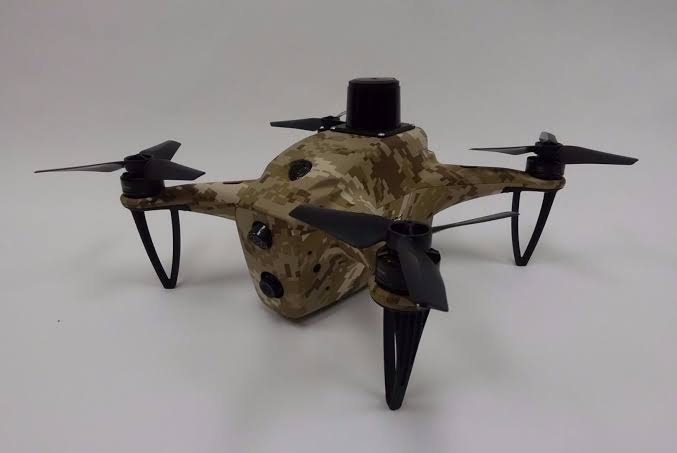A Rare Military Tech Unicorn Looks Past Afghanistan War
Shield AI initially made drones to protect ground troops, but it has raised $210 million to expand to larger aircraft in more complicated situations.

Brandon Tseng, a former Navy SEAL who served in Afghanistan and other overseas deployments, developed the idea for his startup Shield AI to solve a problem specific to what he and his colleagues saw in the field. One of the most dangerous tasks for American ground troops in the Middle East was entering buildings that might contain armed fighters. So Shield, founded in 2015, built fleets of small, autonomous drones that would go in first and send photos and maps to soldiers waiting nearby.
The U.S. military has used Shield’s technology in Afghanistan, Iraq, and Syria. The end of U.S. involvement in Afghanistan marks a new era for the military—and for Shield. The company has spent the better part of the year acquiring new technology and pitching officials and investors on a future beyond the Middle East. That includes the potential for conflicts with China or Russia, according to Tseng and other senior employees.
On Aug. 24, Shield said it raised $210 million from investors including Disruptive Technology Advisers, which valued the company at about $1.25 billion. That makes Shield one of the few unicorns serving the military sector. It’s closing on an additional $90 million in debt and equity investment in the next several weeks, the company says. (Bloomberg Beta, the venture capital arm of Bloomberg LP, the parent of Bloomberg Businessweek, invested in Shield’s early financing rounds.)
Shield secured about $17 million in military contracts in 2020, according to Tech Inquiry, a corporate watchdog that tracks military contracting. That’s easily the company’s best year to date, but it’s a rounding error in a Pentagon budget that regularly exceeds $700 billion. Early this year, Shield started an internal government relations department and hired a former lobbyist from data mining company Palantir Technologies Inc. and a former congressional staffer to run it. The company has spent $430,000 so far in 2021, the first direct lobbying in its six-year history.
Afghanistan’s fall to the Taliban in August cast a grim shadow over the startup. Many of its 200 employees are veterans, and some have spent their days frantically trying to secure aid for friends trapped in the country. “Sadness is by far the overwhelming emotion,” says Tseng, the co-founder and chief operating officer.
Shield executives spent the end of August at their San Diego headquarters, holding the first extended face-to-face meetings with the leaders of two companies acquired this summer. One of them, Martin UAV, makes drones that are as large as 125 pounds. They can be launched from the back of a pickup truck and are able to hover for 11 hours. The other, Heron Systems, makes software designed to control fighter jets.
Shield’s plan is to combine its system with those of its recent acquisitions. This could manifest as a single AI able to control multiple autonomous or semiautonomous vehicles as large as an airplane, working together in complicated tactical situations, Shield executives say. As of now, this wouldn’t include anything that could be described as autonomous weaponry. Tseng says he doesn’t object to building weapons, but Shield isn’t currently focused on doing so.
Military officials acknowledge the virtues of software in battle, but they don’t entirely trust it yet, says Brett Goldstein, the former head of the Pentagon’s Defense Digital Service unit. “Companies are going to have to make some hard choices about what works well and what isn’t working. Particularly, they need to be honest and transparent about systems and algorithms that are not accurate,” he says. “If I’m using Apple Photos and I get a false positive for a dog in a picture, no big deal. For military applications, poor accuracy can get people killed.”
Heron Systems has already participated in an exercise by the U.S. Department of Defense explicitly designed to increase that trust. Last summer it won a dogfighting contest for computers organized by the Defense Advanced Research Projects Agency, the government’s premier research and development arm. Heron’s AI defeated a human F-16 pilot in five consecutive simulated competitions, beating out other entrants, including Lockheed Martin Corp.
Representatives for Darpa have said potential systems like Heron’s are meant to assist human pilots rather than replace them. Heron’s virtual brain has a while to go before being deployed in anything approaching real-life combat. Heron won the contest, which was conducted entirely as a software simulation, by doing things that could have proven disastrous in the air, like flying terrifyingly close to opponents or attacking in ways that might have destroyed both planes, according to Brett Darcey, the founder of Heron’s product development group. Since the competition, Heron has begun testing with real drones in North Carolina.
Getting anyone in the Pentagon to consider programming Heron’s system into fighter jets would have been prohibitively difficult before Shield, says Darcey. The parent company already proved its mettle in Afghanistan and now has the resources to influence government spending. It can play off a palpable fear from U.S. officials of falling behind China technologically. As far back as 2018, then-Defense Secretary Jim Mattis said the shift from terrorism to competing with world powers saw the U.S. “emerging from a period of strategic atrophy.”
Artificial intelligence is the next arms race, according to Darcey. “We were paddling ahead of the waves so we could jump on our surfboard and get on,” he says. “The wave is coming.”